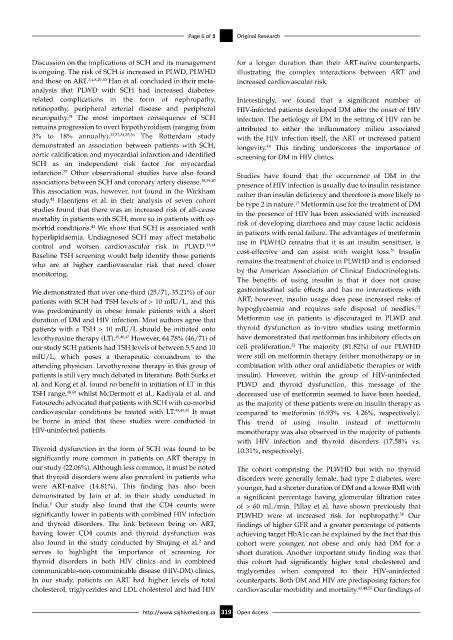Page 327 - HIVMED_v21_i1.indb
P. 327
Page 6 of 8 Original Research
Discussion on the implications of SCH and its management for a longer duration than their ART-naïve counterparts,
is ongoing. The risk of SCH is increased in PLWD, PLWHD illustrating the complex interactions between ART and
and those on ART. 3,4,8,29,30 Han et al. concluded in their meta- increased cardiovascular risk.
analysis that PLWD with SCH had increased diabetes-
related complications in the form of nephropathy, Interestingly, we found that a significant number of
retinopathy, peripheral arterial disease and peripheral HIV-infected patients developed DM after the onset of HIV
neuropathy. The most important consequence of SCH infection. The aetiology of DM in the setting of HIV can be
31
remains progression to overt hypothyroidism (ranging from attributed to either the inflammatory milieu associated
3% to 18% annually). 32,33,34,35,36 The Rotterdam study with the HIV infection itself, the ART or increased patient
demonstrated an association between patients with SCH, longevity. This finding underscores the importance of
14
aortic calcification and myocardial infarction and identified screening for DM in HIV clinics.
SCH as an independent risk factor for myocardial
infarction. Other observational studies have also found Studies have found that the occurrence of DM in the
37
associations between SCH and coronary artery disease. 38,39,40 presence of HIV infection is usually due to insulin resistance
This association was, however, not found in the Wickham rather than insulin deficiency and therefore is more likely to
41
study. Haentjens et al. in their analysis of seven cohort be type 2 in nature. Metformin use for the treatment of DM
13
studies found that there was an increased risk of all-cause in the presence of HIV has been associated with increased
mortality in patients with SCH, more so in patients with co- risk of developing diarrhoea and may cause lactic acidosis
42
morbid conditions. We show that SCH is associated with in patients with renal failure. The advantages of metformin
hyperlipidaemia. Undiagnosed SCH may affect metabolic
control and worsen cardiovascular risk in PLWD. 43,44 use in PLWHD remains that it is an insulin sensitiser, is
51
Baseline TSH screening would help identify those patients cost-effective and can assist with weight loss. Insulin
who are at higher cardiovascular risk that need closer remains the treatment of choice in PLWHD and is endorsed
monitoring. by the American Association of Clinical Endocrinologists.
The benefits of using insulin is that it does not cause
We demonstrated that over one-third (25/71, 35.21%) of our gastrointestinal side effects and has no interactions with
patients with SCH had TSH levels of > 10 mIU/L, and this ART; however, insulin usage does pose increased risks of
52
was predominantly in obese female patients with a short hypoglycaemia and requires safe disposal of needles.
duration of DM and HIV infection. Most authors agree that Metformin use in patients is discouraged in PLWD and
patients with a TSH > 10 mIU/L should be initiated onto thyroid dysfunction as in-vitro studies using metformin
levothyroxine therapy (LT). 45,46,47 However, 64.78% (46/71) of have demonstrated that metformin has inhibitory effects on
53
our study SCH patients had TSH levels of between 5.5 and 10 cell proliferation. The majority (81.82%) of our PLWHD
mIU/L, which poses a therapeutic conundrum to the were still on metformin therapy (either monotherapy or in
attending physician. Levothyroxine therapy in this group of combination with other oral antidiabetic therapies or with
patients is still very much debated in literature. Both Surks et insulin). However, within the group of HIV-uninfected
al. and Kong et al. found no benefit in initiation of LT in this PLWD and thyroid dysfunction, this message of the
TSH range, 48,49 whilst McDermott et al., Kadiyala et al. and decreased use of metformin seemed to have been heeded,
Fatourechi advocated that patients with SCH with co-morbid as the majority of these patients were on insulin therapy as
cardiovascular conditions be treated with LT. 45,46,50 It must compared to metformin (6.93% vs. 4.26%, respectively).
be borne in mind that these studies were conducted in This trend of using insulin instead of metformin
HIV-uninfected patients. monotherapy was also observed in the majority of patients
with HIV infection and thyroid disorders (17.58% vs.
Thyroid dysfunction in the form of SCH was found to be 10.31%, respectively).
significantly more common in patients on ART therapy in
our study (22.06%). Although less common, it must be noted The cohort comprising the PLWHD but with no thyroid
that thyroid disorders were also prevalent in patients who disorders were generally female, had type 2 diabetes, were
were ART-naïve (14.81%). This finding has also been younger, had a shorter duration of DM and a lower BMI with
demonstrated by Jain et al. in their study conducted in a significant percentage having glomerular filtration rates
India. Our study also found that the CD4 counts were of > 60 mL/min. Pillay et al. have shown previously that
5
significantly lower in patients with combined HIV infection PLWHD were at increased risk for nephropathy. Our
54
and thyroid disorders. The link between being on ART, findings of higher GFR and a greater percentage of patients
having lower CD4 counts and thyroid dysfunction was achieving target HbA1c can be explained by the fact that this
also found in the study conducted by Shujing et al. and cohort were younger, not obese and only had DM for a
2
serves to highlight the importance of screening for short duration. Another important study finding was that
thyroid disorders in both HIV clinics and in combined this cohort had significantly higher total cholesterol and
communicable–non-communicable disease (HIV-DM) clinics. triglycerides when compared to their HIV-uninfected
In our study, patients on ART had higher levels of total counterparts. Both DM and HIV are predisposing factors for
cholesterol, triglycerides and LDL cholesterol and had HIV cardiovascular morbidity and mortality. 43,44,55 Our findings of
http://www.sajhivmed.org.za 319 Open Access

